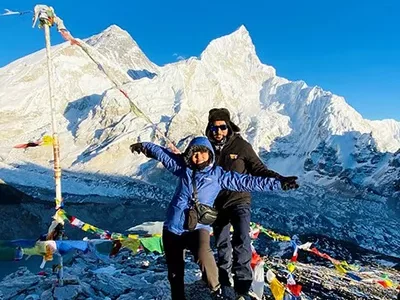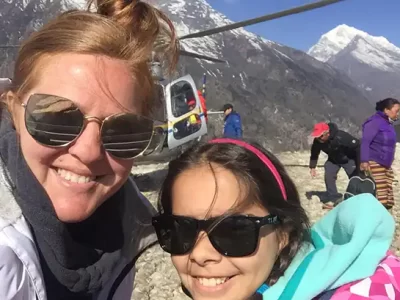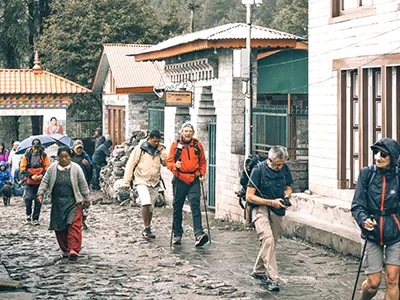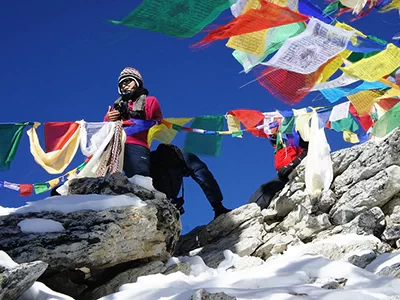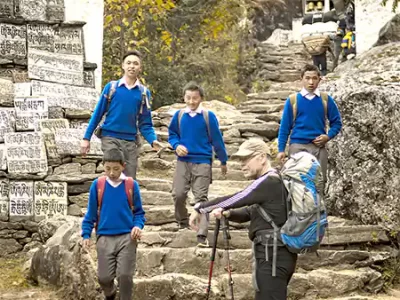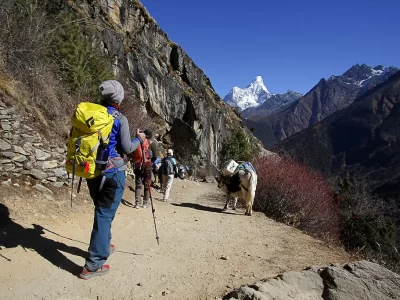Nestled in the stunning Khumbu region, Lobuche Nepal is a high-altitude settlement renowned among trekkers and adventurers from around the globe. This quaint village sits at a formidable Lobuche elevation of nearly 4,940 meters, making it a crucial junction for those venturing deeper into the heart of the Himalayas.
This place offers a unique blend of natural splendor and essential trekking amenities, surrounded by the rugged beauty of towering peaks and vast landscapes. The allure of Lobuche extends beyond its scenic vistas.
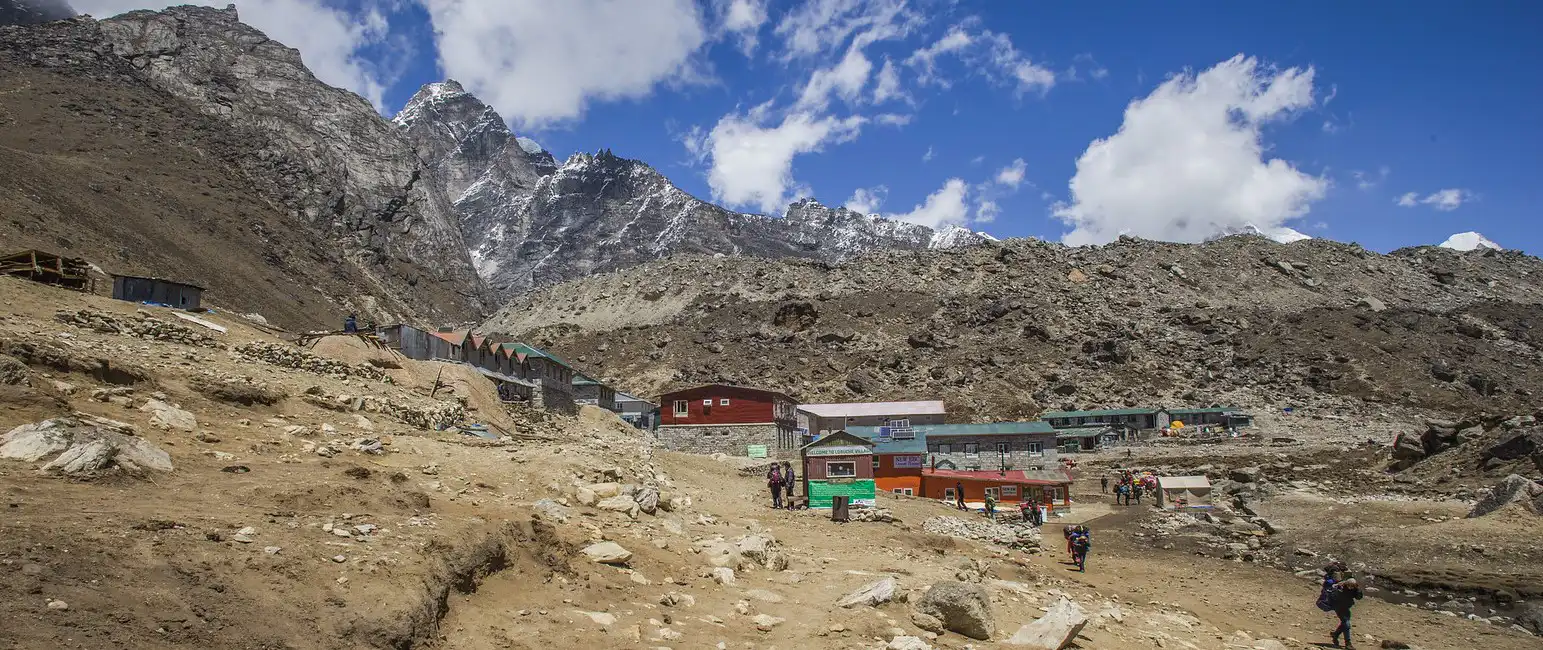
A settlement developed primarily to support trekking expeditions, it provides a range of accommodations, from cozy lodges to well-equipped guesthouses, catering to the needs of weary travelers seeking comfort in this remote part of the world.
A Vital Junction on the Himalayan Path
Lobuche’s location on the trekking routes leads directly to Everest Base Camp and other iconic Himalayan summits. Its location provides adventurers a crucial opportunity to acclimate to the thin air and prepare for the challenges that await them. The village thrives as a bustling hub, offering essential provisions, cozy accommodations, and a warm sense of community among fellow travelers.
A Visual Symphony: Lobuche’s Scenic Grandeur
Brace yourself for a breathtaking spectacle as you explore the magnificent landscape around Lobuche. This village offers an unparalleled vantage point for some of the most stunning vistas on Earth.
- Lobuche Peak: This majestic peak, soaring to 6,119 meters (20,075 feet), commands the skyline, its snow-clad slopes shimmering under the sun. It’s a popular choice for acclimatization climbs and a photographer’s paradise.
- Nuptse: This formidable mountain, standing shoulder-to-shoulder with Everest, presents a daunting challenge to climbers. Its vertical walls and jagged ridges create a dramatic spectacle against the Lobuche landscape.
- Khumbu Glacier: This immense river of ice, descending from the flanks of Everest, serves as a humbling reminder of nature’s power. Witnessing its vast expanse and ever-shifting formations is an unforgettable experience.
- Everest: Although not directly visible from this place, the presence of the world’s highest mountain is undeniable. Knowing you’re near this legendary peak adds an extra thrill to your adventure.
Everest Base Camp Trek
Everest Base Camp Trek with Helicopter Return
Luxury Everest Base Camp Trek
Lobuche Village: Where Sherpa Traditions Thrive in the Himalayas
High in the heart of Nepal’s Khumbu region, discover the village of Lobuche, a living testament to the enduring spirit and vibrant culture of the Sherpa people. This place offers more than just a rest stop on the way to Everest Base Camp; it provides a unique glimpse into this remarkable community’s customs and daily life.
Centuries of Culture and History Etched into the Mountains
The history of Lobuche intertwines with the Sherpa people’s profound connection to the mountains. For generations, they have navigated these challenging landscapes, their lives shaped by the rhythms of the Himalayas. The village’s peaceful atmosphere and fluttering prayer flags reflect its Buddhist heritage.
The Sherpa Way: Resilience and Harmony
The Sherpas of Lobuche are known for their warmth, hospitality, and unwavering resilience. Their lives revolve around a deep reverence for nature and a strong sense of community. Observing their daily routines offers a window into a lifestyle that is both humbling and inspiring.
- Farming and Animal Care: The Sherpas skillfully cultivate crops like potatoes and barley on terraced fields despite the harsh environment. They also raise yaks and other livestock, which provide vital resources such as milk, wool, and transportation.
- Tourism and Mountaineering Expertise: As trekking and mountaineering have grown, many Sherpas have become guides and porters, sharing their invaluable knowledge of the mountains with visitors from across the globe.
- Traditional Craftsmanship: The Sherpas are talented artisans who create intricate handicrafts, such as woven textiles and hand-carved wooden objects. These crafts not only express their creativity but also offer a crucial source of income.
- Festivals and Celebrations: The Sherpa calendar has lively festivals celebrating their culture and spirituality. Losar, the Sherpa New Year, and Dumje, a festival honoring mountain deities, are incredibly joyous occasions brimming with music, dance, and festive meals.
Embrace the Cultural Richness of Lobuche
Visitors to Lobuche have the unique opportunity to interact with the Sherpa community and learn about their distinctive way of life. Here are a few ways to experience the cultural depth of this Himalayan village:
- Find serenity at a local monastery: The monasteries in and around this place provide a tranquil space for reflection and a chance to observe Buddhist practices.
- Savor Sherpa cuisine: Delight in traditional dishes like momos (dumplings) and thukpa (noodle soup) at one of the village’s tea houses or restaurants.
- Connect with the locals: The Sherpas are known for their friendly and welcoming nature. Take the time to converse with the locals, learn about their lives, and cultivate a profound appreciation for their culture.
- Support the community by purchasing local handicrafts. Buy authentic souvenirs directly from the artisans and contribute to the local economy.
Lobuche’s Twin Peaks: Choose Your Himalayan Challenge
Nestled in the breathtaking Himalayan landscape of Nepal, the Lobuche massif beckons adventurers with its two distinct peaks: Lobuche East and Lobuche West. Each summit offers a unique experience, catering to varying ambitions and mountaineering expertise.
Lobuche East: A Trekker’s Gateway to the High Peaks
Rising to an impressive 6,119 meters (20,075 feet), Lobuche East is a popular choice for trekkers seeking a thrilling acclimatization climb before venturing to even higher summits like Everest.
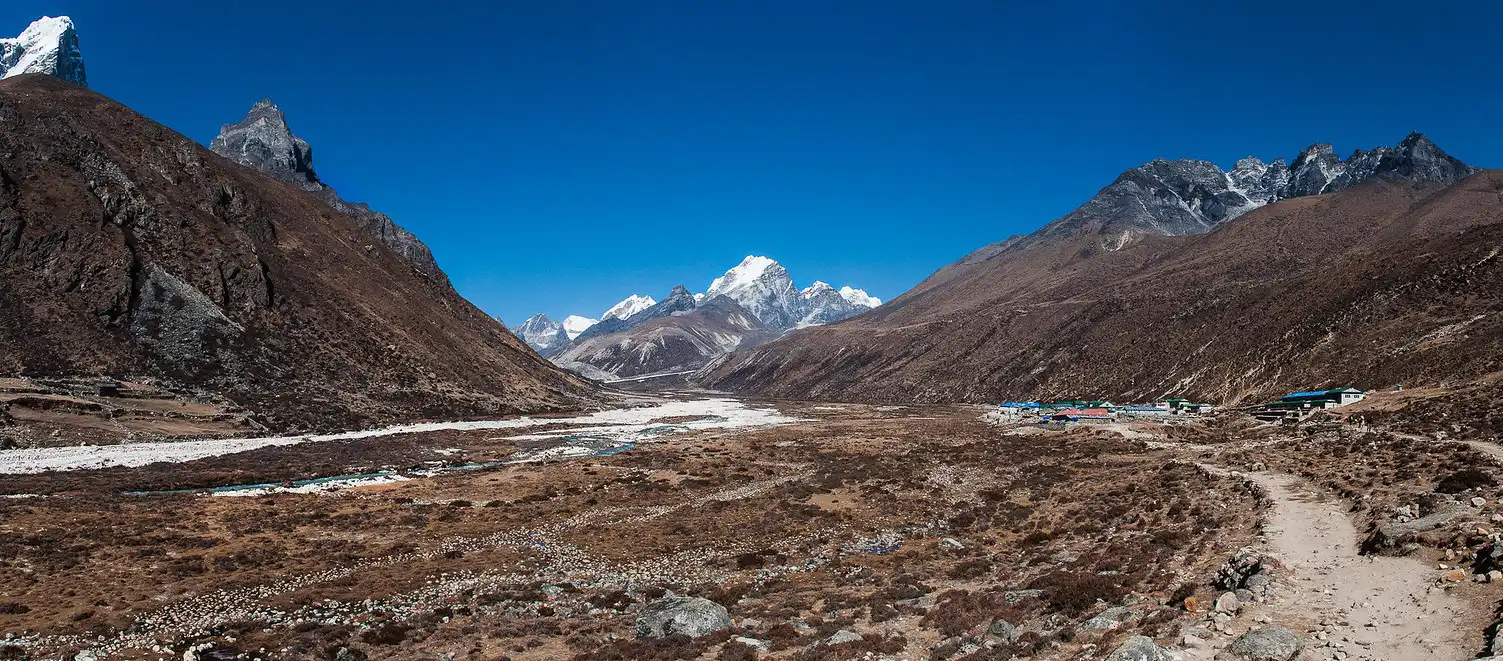
Its relatively straightforward route and awe-inspiring summit vistas make it an appealing option for those eager to push their boundaries in a spectacular setting.
- The Ascent: The climb typically starts from Lobuche High Camp, following a clear trail up the mountain. The final push to the summit involves navigating a mix of rocky terrain and snow, requiring some basic mountaineering skills.
- Level of Challenge: The climb to Lobuche East, though not technically demanding, still poses challenges due to the high altitude and unpredictable Lobuche weather. Previous trekking experience and a high level of physical fitness are essential.
- Necessary Permits: To climb Lobuche East, you’ll need a trekking permit for the Everest region. You can obtain this through a registered trekking agency in Nepal.
Lobuche West: A Climber’s Test of Skill
Lobuche West, standing tall at 6,145 meters (20,161 feet), is a more formidable peak that calls to seasoned climbers craving a technical challenge. Its steep slopes, exposed ridges, and potential for avalanches demand advanced mountaineering skills and a high level of physical fitness.
- Climbing Route: The standard ascent of Lobuche West is demanding, encompassing steep snow and ice sections, rocky terrain, and a sharp, exposed ridge.
- Level of Difficulty: This climb is technically challenging and requires prior mountaineering experience, including crampons, ice axes, and ropes.
- Permits Required: In addition to the Everest region trekking permit, you’ll also need a climbing permit for Lobuche West. You can obtain this through a registered mountaineering expedition operator in Nepal.
Everest High Pass Trek
Everest Panorama Trek
Everest Base Camp Short Trek
Finding Comfort at High Altitude: Accommodations and Dining in Lobuche, Nepal
Lobuche caters to all budgets and tastes with various lodging and dining choices. Despite its remote location, Lobuche village has adapted to provide the comforts adventurers need in this awe-inspiring region.
Where to Rest Your Head
- Tea Houses: The Heart of Himalayan Hospitality – These traditional lodges form the backbone of accommodation in the Everest region. They provide basic but cozy rooms with shared bathrooms. Tea houses create a warm, communal atmosphere where travelers can swap stories in the dining hall and cozy up by the fire. They’re budget-friendly and often include meals in the price.
- Lodges: A Touch of Extra Comfort – Lodges are great for more amenities. They have private rooms with attached bathrooms and sometimes even hot showers – a real treat at this altitude! While pricier than tea houses, lodges give you more comfort and privacy.
- Camping: Embrace the Wild – While less common in Lobuche itself, camping is an option for those with their equipment and a yearning for a closer connection to nature. Remember to check with local authorities about designated camping areas and any rules.
Choosing the Right Fit
- Your Budget: Tea houses are the most economical choice, while lodges and camping are pricier.
- Your Comfort Level: You might prefer a lodge if private bathrooms and extra amenities are essential.
- Your Experience: Seasoned trekkers and climbers comfortable with basic facilities often enjoy the tea house experience.
- Your Group Size: Larger groups may find lodges or camping more accommodating.
Fueling Your Adventure: Dining in Lobuche
Though simple, the food scene in this place caters perfectly to those tackling high-altitude adventures.
- Tea Houses and Lodges: Home-Cooked Goodness – Most places to stay offer meals in their dining halls. Expect hearty, filling dishes like dal bhat (rice and lentils), noodle soups, and pasta. Many also have Western choices like pizza and burgers.
- Bakeries: Freshly Baked Delights: The aroma of freshly baked goods wafts through Lobuche’s streets, tempting trekkers with various treats from the village’s several bakeries, ideal for breakfast or a quick energy boost on the trail.
- Snacks and Drinks: On-the-Go Energy Small shops sell snacks, energy bars, chocolate, bottled water, and soft drinks. Remember, staying hydrated is vital at high altitudes.
Tips for Dining in Lobuche
- Plan for Early Dinners: They usually serve dinner early in the evening.
- Pack Trail Snacks: Take extra snacks for your hikes because you may find limited options between villages.
- Stay Hydrated: Stay hydrated to prevent altitude sickness.
Choosing the Perfect Time for your Himalayan Adventure
Lobuche, nestled high in the Himalayas, captivates trekkers and climbers with its breathtaking beauty throughout the year. Understanding Lobuche weather patterns is critical for planning a safe and enjoyable experience.
Weather in Lobuche: A Year-Round Guide
Lobuche’s high altitude, reaching 4,940 meters (16,207 feet), significantly influences its climate. The weather here is known for its cold temperatures, strong winds, and the chance of snowfall even in the warmer months.
- Spring (March-May): Spring ushers in warmer temperatures and longer days, making it an ideal time for a visit. Expect daytime highs between a chilly -5°C to a milder ten °C (23°F to 50°F), while nighttime temperatures can plunge to -15°C (5°F) or even colder. The skies are typically clear, revealing stunning mountain vistas.
- Summer/Monsoon (June-August): Summer in this place brings the monsoon season. Although temperatures remain mild, frequent rain and cloud cover often obscure the views. Trekking during this period can be treacherous, with slippery trails and the potential for landslides.
- Autumn (September-November): As the monsoon fades, autumn emerges with its stable weather, clear skies, and comfortable temperatures. Daytime highs range from -5°C to 10°C (23°F to 50°F), perfect for trekking.
- Winter (December-February): Winter in this place is harsh, with heavy snowfall and temperatures that can plummet to a bone-chilling -20°C (-4°F) or below. While the scenery transforms into a winter wonderland, trekking during this season requires thorough preparation and specialized cold-weather gear.
When to Plan Your Lobuche Trek
The best time to trek in the Lobuche region depends on your preferences and priorities.
- Clear Views and Pleasant Weather: If you’re seeking the most comfortable temperatures and stunning vistas, spring (March-May) and autumn (September-November) are the prime seasons to visit. The weather is stable, and the skies are usually clear, revealing the full glory of the mountains.
- Escape the Crowds: To enjoy a more solitary experience on the trails, consider visiting during the shoulder seasons of April-May or September-October.
- Embrace the Winter Adventure: For seasoned trekkers seeking a unique challenge and the allure of snow-covered landscapes, winter trekking in this place can be incredibly rewarding.
Important Considerations
- Acclimatization is Essential: Regardless of when you visit, allow yourself plenty of time to acclimatize to Lobuche’s high altitude. Include rest days in your itinerary to let your body adjust to the thinner air.
- Pack for All Weather: Even during the popular trekking seasons, be prepared for unpredictable weather—pack layers of warm clothing, waterproof outerwear, sturdy hiking boots, and a high-quality sleeping bag.
- Secure Your Permits: Remember, you’ll need permits to trek in the Everest region and climb Lobuche East.
Trekking in Lobuche, Nepal: Trails to Breathtaking Himalayan Views
Perched high in the Khumbu Valley, the Sherpa village of Lobuche is a crucial gateway for treks leading to the iconic Everest Base Camp and other scenic marvels. Its spectacular location immerses trekkers in a world of towering peaks, ancient glaciers, and trails winding through an awe-inspiring landscape.
The Classic Trek: From Lobuche to Everest Base Camp
The trek from Lobuche to Everest Base Camp is a highlight for adventurers worldwide. It’s a demanding but incredibly rewarding trek, taking you through diverse terrain and offering views you’ll always remember.
Distance and Altitude Gain: The trek stretches roughly 6-7 kilometers (3.7-4.3 miles) with a steady climb. You’ll start at Lobuche’s altitude of 4,940 meters (16,207 feet) and ascend to Everest Base Camp at 5,364 meters (17,598 feet).
Trail Highlights
- The trail meanders through the rugged Khumbu Glacier, an immense river of ice.
- You’ll pass through Gorakshep, a small village that serves as the last stop, before reaching Everest Base Camp.
- The trek concludes at the iconic Everest Base Camp, the legendary departure point for those aiming for the summit.
Trek Duration: The trek will take 3-4 hours, though your fitness and altitude adjustment can affect this.
Explore Beyond Base Camp: Other Treks Near Lobuche
Lobuche is also the starting point for several other captivating treks in the region.
- Kala Patthar: Everest’s Best Vantage Point: To experience arguably the most spectacular views of Everest, hike up to Kala Patthar (5,643 meters/18,514 feet). The trail is a steep climb from Gorakshep, but the extraordinary panoramic vistas from the summit make every step worthwhile.
- Lobuche East: A Peak for Acclimatization: Climbing Lobuche East is a popular way to acclimatize before tackling higher peaks. The route starts from Lobuche High Camp, which has stunning views from the top.
- Khumbu Glacier Exploration: Begin on a guided hike onto the Khumbu Glacier for a unique opportunity to witness this massive ice formation’s raw power and beauty up close.
Altitude Awareness: A Vital Aspect of Your Trek
Even seasoned trekkers can face challenges at high altitudes. Situated at a lofty 4,940 meters (16,207 feet), the Himalayan village of Lobuche demands respect. Understanding and preparing for altitude sickness is paramount for a safe and enjoyable experience.
Acclimatization: Letting Your Body Adapt
Acclimatization is your body’s way of adjusting to the thinner air at high altitudes. It’s crucial to give your body enough time to adapt to the Lobuche elevation to minimize the risk of altitude-related illnesses.
Practical Tips for a Smooth Transition
- Ascend Gradually: Embrace the “climb high, sleep low” principle. Climb to higher altitudes daily, then descend to a lower elevation for rest. It allows your body to adapt gradually.
- Schedule Rest Days: Ensure your itinerary includes rest days, particularly following substantial increases in altitude. Your body needs time to catch up.
- Hydrate, Hydrate, Hydrate: To prevent dehydration, increase your water intake and reduce consumption of dehydrating beverages like alcohol and caffeine.
- Fuel Your Body Wisely: Eat a balanced diet of carbohydrates for energy, and avoid overeating.
- Listen to Your Body’s Signals: Be alert for signs of altitude sickness, including headache, nausea, fatigue, or difficulty breathing. If you experience any concerns, notify your guide or trekking companions immediately.
Preventive Measures for a Safer Trek
- Consider Medication: Talk to your doctor about medications like acetazolamide (Diamox), which can help prevent altitude sickness.
- Maintain a Steady Pace: Trek comfortably and avoid pushing yourself too hard.
- Say No to Smoking and Alcohol: These substances can worsen the effects of altitude sickness.
Seeking Medical Help
If you experience symptoms of altitude sickness, don’t hesitate to seek help.
- Alert Your Guide: Your trek leader or guide can identify and handle altitude-related issues. They can offer immediate assistance and advice.
- Descend if Needed: Lowering your altitude is the most effective treatment for severe altitude sickness.
Additional Safety Tips for Your Himalayan Adventure
- Prepare for Changing Weather: The weather in the mountains can shift quickly. Even in peak trekking seasons, always carry appropriate clothing and gear, including rain gear and warm layers.
- Respect the Local Culture: Be mindful of the customs and traditions of the Sherpa people. Maintain modest attire, request authorization before taking pictures, and refrain from disturbing religious sites.
- Secure Your Permits: Ensure you have the necessary permits for your trek. You will need a license for the Everest region and an additional climbing permit if you plan to climb a peak like Lobuche East.
- Travel Insurance is a Must: Comprehensive travel insurance that covers high-altitude trekking and emergency evacuation is crucial.
Picture-Perfect Moments: Photography in Lobuche
Nestled amongst the world’s most majestic peaks, Lobuche offers countless opportunities to capture breathtaking photos. Here are a few must-visit locations for photographers:
- Kala Patthar: The Everest Panorama – Kala Patthar, arguably the most iconic viewpoint in the Everest region, reveals a sweeping panorama of Mount Everest, Nuptse, and the surrounding glaciers.
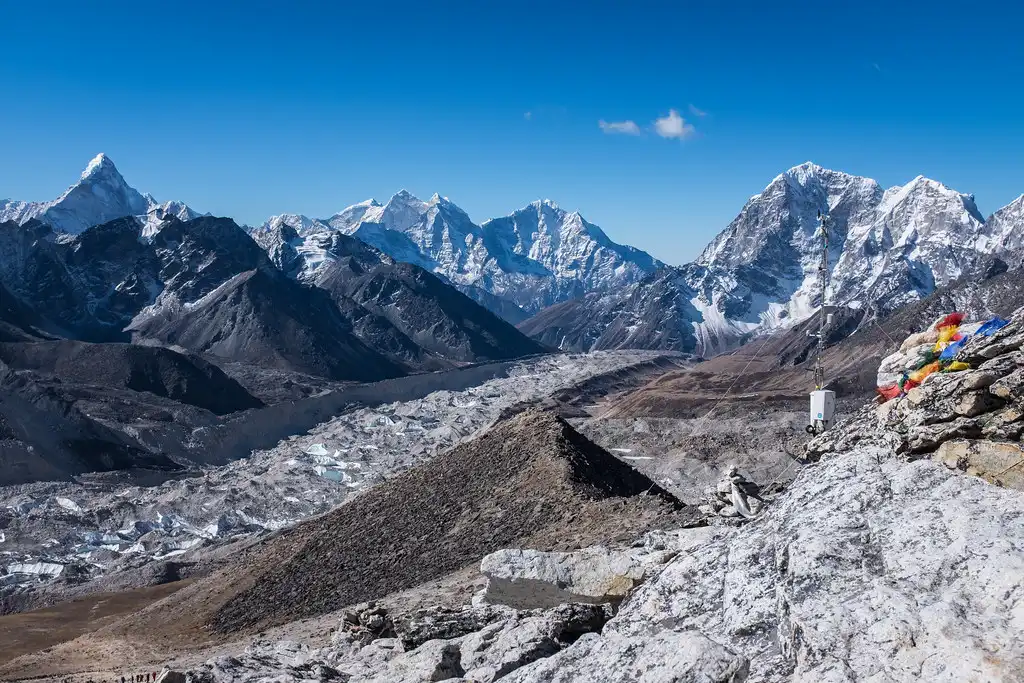
Sunrise and sunset paint the sky in vibrant hues, creating magical photo opportunities.
- Lobuche East Summit: A 360-Degree Spectacle – Conquer this trekking peak and be rewarded with all-encompassing views of the Himalayas, featuring giants like Everest, Lhotse, and Makalu.
- Khumbu Glacier: A Photographer’s Playground – This massive ice flow offers endless photographic inspiration. Capture its ever-shifting formations, dramatic seracs, and cascading icefalls.
- Lobuche Village: A Glimpse of Sherpa Life – The village itself, with its traditional stone houses and colorful prayer flags, provides a window into Sherpa culture, perfect for capturing authentic moments.
- The Trail to Everest Base Camp: A Visual trek – As you trek from Lobuche to Everest Base Camp, be sure to capture the dramatic scenery, including the awe-inspiring Khumbu Icefall and the prayer flags fluttering at Gorakshep.
Photography Tips
- Pack Smart: Pack light for your trek, but remember the photography essentials: your camera, extra batteries, memory cards, a tripod for steady shots, and lens filters to elevate your images.
- Respect Nature: Avoid disturbing the natural surroundings and wildlife. Stay on marked paths and leave the environment as you found it.
- Embrace Patience: Mountain weather can be fickle. Wait for the clouds to part or the light to shift to capture that perfect moment.
- Connect with Locals: With their permission, respectfully photograph the Sherpa people to capture their warmth and spirit.
Conservation in Lobuche: Safeguarding a Fragile Ecosystem
The delicate Himalayan ecosystem faces various environmental pressures. As a visitor to Lobuche, responsible tourism is essential.
- Manage waste Responsibly: Pack out all your trash and avoid single-use plastics.
- Observe Wildlife with Care: Keep a safe distance and observe animals without disturbing or feeding them. Appreciate their beauty from afar.
- Stick to the Trails: Help protect the environment by following established trails. Avoid creating new trails.
- Support Local Conservation: Contribute to local initiatives or organizations that protect the region.
Sustainable Tourism in Action
Local communities and organizations in Lobuche actively engage in conservation efforts.
- Sagarmatha Pollution Control Committee (SPCC): This organization manages waste and promotes sustainable practices throughout the Everest region.
- Khumbu Climbing Center (KCC): The KCC trains local climbers and guides in safe and environmentally responsible mountaineering techniques.
- Community-Based Tourism: Many lodges and tea houses in Lobuche are owned and operated by Sherpa families, strengthening the local economy and encouraging sustainable tourism.
Your Role in Protecting Lobuche’s Beauty
By making conscious choices during your visit, you can help maintain the delicate balance of Lobuche’s environment.
- Choose Eco-conscious Lodges: Support accommodations prioritizing sustainable practices, such as waste management and energy conservation.
- Minimize Your Impact: Pack light, reuse water bottles, and avoid creating unnecessary waste.
- Respect the Local Culture: Be mindful of the Sherpa people’s traditions and way of life.
Practical Tips for a Smooth Adventure
Planning a high-altitude trek to a place like Lobuche demands careful preparation. These practical tips will help ensure you have the best possible experience:
Getting There
Fly into Kathmandu: Most international flights land in Kathmandu, Nepal’s capital city. From there, you have two main options to reach the Everest region:
- Take a Scenic Flight to Lukla: This is the fastest and most popular way to reach the trekking starting point. Prepare to be mesmerized by the Himalayas from above.
- Trek from Jiri or Salleri: This extended option allows for gradual acclimatization but demands more time and physical endurance.
Trekking in the Khumbu: Once you’re in the Everest region, trekking is the primary way to get around. The trail to Lobuche is well-established, but expect steep climbs and descents.
Permits: Your Gateway to the Mountains
- TIMS Card (Trekkers’ Information Management System): This is a must-have for all trekkers in Nepal. Get it in Kathmandu or Lukla before you start your trek.
- Sagarmatha National Park Entry Permit: You’ll also need this permit, which you can obtain at the park entrance or in Kathmandu.
- Climbing Permit for Lobuche East: If you plan to climb Lobuche East, secure a climbing permit in advance. Your trekking agency can assist you with this.
Local Guides and Porters: Your Trekking Companions
- Why Hire a Guide? Local guides offer invaluable knowledge about the region, culture, and trail conditions. They can also help you acclimatize safely and ensure a smooth trek.
- Porters: Lighten Your Load: Consider hiring a porter if you’re carrying a heavy backpack. They’ll bring your gear, allowing you to enjoy the trek more comfortably and reduce the risk of injury.
More Essential Tips
- Acclimatization is Key: Spend a few days in Namche Bazaar or Dingboche to acclimatize before ascending to the higher altitude of Lobuche.
- Travel Insurance is Essential: Ensure your insurance covers high-altitude trekking and emergency evacuation.
- Respect Local Customs: Dress modestly and be mindful of the local culture and traditions.
- Pack Smart: Bring clothing and gear suitable for the unpredictable mountain weather, including warm layers, waterproof items, and sturdy hiking boots.
- Cash is King: Although some lodges accept credit cards, carry enough cash to cover your expenses throughout the trek.
- Stay Connected: While internet and mobile connectivity are available in Lobuche, they can be unreliable. Consider purchasing a local SIM card for better service.

